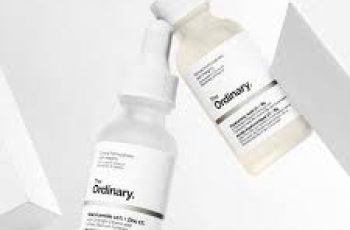
What Can You Not Mix with AHA and BHA?
If you don’t use an AHA or BHA in your daily skincare routine, chances are you have at least heard of this collection of chemical exfoliants before. Both groups of acids each deliver impressive and desirable benefits on the skin.
What are AHAs?
Alpha hydroxy acids (AHA) are a group of chemical exfoliants that work on the upper surface if the skin by ridding it of the build-up of dead skin cells, dirt, debris, bacteria, and other impurities which if left to sit on the skin will develop into such concerns as spots, acne, blemishes, and a flaky lack lustre complexion. The most common AHAs are glycolic acid and lactic acid which are formulated into many popular skincare products, like toners and serums. These are effective at also combating signs of ageing, such as fine lines, wrinkles ad well as areas of hyperpigmentation, dark spots, and sun damage.
AHAs molecular size is usually quite large meaning they are unable to penetrate the lower layers of the skin and ensure you avoid too much irritation.
What are BHAs?
Beta hydroxy acids (BHA) are the cousins of AHAs and generally perform similar exfoliating properties. The main difference is you’ll find BHAs are not as readily available in over-the-counter products such as AHAs, instead you’ll find they are used in professional treatments such as chemical peels. The most common BHA is salicylic acid, which like the other acids mentioned works at sloughing the skin of dead skin cell build-up and other impurities. Compared to AHAs however you’ll find that salicylic acid is oil-soluble with a small molecular size meaning it can reach deep into the pores and help unclog them of excess sebum, dirt, and bacteria.
Now that you’ve had a recap of what these clever acids do for the skin, let’s explore more and find out what can you not mix with AHAs and BHAs.
What should you not do after AHA BHA?
Some of the main skincare ingredients you should not apply to the skin after using AHA and BHA are the following.
Vitamin C
Retinol
Benzoyl peroxide
Physical exfoliating scrubs
This doesn’t mean you should not use these actives all together, but it just requires you to alternate the time of day you apply them. Ideally you would need to leave about 40 minutes in between applications as this will ensure the pH levels of the skin are rebalanced ready for any following products. Remember not to rush any introduction of new ingredients or products into your routine, especially if it is one that is working effectively for you. Ensure you opt for skincare products that complement each other and will help you reap the rewards of an effective routine.
What can I layer with AHA and BHA?
With both BHA and AHA performing exfoliation on the skin it is considered best to team them with hydrating and nourishing ingredients, such as hyaluronic acid, niacinamide, squalene, or glycerin. All of which aid moisture to the skin and help to calm and soothe after the exfoliating of the acids revealing fresh skin cells that often require a helping hand in keeping healthy and protected from exposure to free radicals, such as UV rays, pollution, and other environmental aggressors.
If you find yourself with any worries about layering active skin ingredients together, it’s best to perform a patch test for 24 hours. You can do this by applying a 10 pence size amount of product on the forearm, once the 24 hours have passed and there are no signs of irritation, you are able to apply the product to your face.
Can you use niacinamide after AHA BHA?
Yes, you can, but always ensure you apply it during the optimal time of day to avoid any unwanted irritation or reactions. By this I mean depending on the type of products that contain AHAs or BHAs will help you establish when in your routine you should apply niacinamide. The general skincare rule is to apply products from thinnest to thickest to avoid any physical barriers forming on the skin surface and preventing products to penetrate the skin. You’ll often find that niacinamide is formulated into serums or moisturisers which are applied to the skin during the later stages of your routine. This leaves enough time for you to use a toner enriched in an AHA, such as glycolic acid which will slough away dead skin cells before niacinamide helps the skin to regulate its sebum production and locks moisture into the protective barrier.
There is a completely dedicated blog post about mixing AHA and BHA with niacinamide over on The Beauty Insiders, so do check that out if you wanted to find out more.
Can you mix AHA and BHA with hyaluronic acid?
Absolutely, hyaluronic acid is one of the very few skin ingredients that can be teamed with almost every other active ingredient, even ones as potent as the BHA, salicylic acid. For optimal results and no signs of potential dryness caused by the AHA or BHA you’ll often find serum formulations contain both exfoliant and hyaluronic acid, this is ideal for getting the best of both worlds, but you are also able to use separate products to layer to achieve the same hydrating and skin reviving results.
If you wanted to find out more about the best way of layering hyaluronic acid with BHA, check out our dedicated blog post which goes into more detail.
There you have a little more information about what can you not mix with AHA and BHA, as complicated as it may feel at first, you’ll find that once you have a better understanding you are able to really notice an improvement in your complexion. With an established skincare routine, you’ll feel apprehensive about introducing any new products at the risk of causing the skin to flare-up, stick at it though and work slowly at introducing any new skin ingredients. You should also always consult with a doctor or dermatologist for the peace of mind you and your skin will love what you use. Don’t forget to come and find us over on Instagram for daily skin expert tips, new products, and discounts.
DQH Can I use salicylic acid first and then vitamin C?
It’s easy to create a skincare routine, but knowing how to use it is another thing entirely. In most cases, if you’re not getting the desired skin results, it could be due to the layering of conflicting ingredients. So, is it possible that salicylic acid and vitamin C are such ingredients? Or are these active ingredients the duo that’s been missing from your skincare routine? If you want answers, stick around because today we are going to explain the benefits of salicylic acid and vitamin C and how they can be used in your daily life.
What are the benefits of salicylic acid for skin?
Salicylic acid is one of the most commonly used beta hydroxy acids and is favored by many people with oily, acne-prone skin. This acid is derived from willow bark, and unlike its water-soluble relatives (called alpha-hydroxy acids), salicylic acid is oil-soluble, which means it can penetrate deeper into the lower layers of the skin. Once it reaches the lower layers, it can help unclog pores of excess sebum, dirt, bacteria, debris, and impurities. This results in clearer skin tones and greater definition.
Not only does salicylic acid benefit the underlying layers, but the outer surface of the skin benefits as well. When applied to the skin, salicylic acid removes the buildup of dead skin cells. This is accomplished by breaking the bonds that hold dead cells to the surface. Over time, this can cause the complexion to look dull and prone to acne, blackheads, and other blemishes.
If you’d like to learn more about salicylic acid and how it can improve your skin, check out this dedicated blog post from a beauty insider.
What are the benefits of vitamin C for skin?
Vitamin C is considered one of the most powerful antioxidants, which means it is very effective at fighting free radicals and preventing them from causing further skin damage. Examples of free radicals include pollution, central heating, UV rays and harsh climate. They attack proteins, fats and cell membranes as soon as they come into contact with the skin, causing signs of premature aging such as fine lines and wrinkles as well as hyperpigmentation, flaky patches of skin and loss of elasticity.
Many people usually prefer to use vitamin C in their morning routine as this ingredient gives the complexion a radiant glow. You’ll also find that vitamin C can target areas of hyperpigmentation, plumping the skin and reducing the appearance of fine lines and wrinkles.
The thing about vitamin C is that there are a lot of outdated studies going back to the 1950s that describe vitamin C as an unstable skin component. Thanks to improvements in modern technology, this is no longer the case as all products now contain a stable form of vitamin C.
Visit The Beauty Insider to learn more about vitamin C. So please check out our blog post.
Can I use salicylic acid first and then vitamin C?
Yes, you absolutely can. In fact, it’s thought that using salicylic acid before using vitamin C ensures it penetrates faster and works faster.
This is an efficient way to utilize two power sources, and the reason has to do with pH. For example, the skin’s natural pH is about 4.7, making it slightly acidic. Salicylic acid and vitamin C are also both acidic, and you’ll find that vitamin C is absorbed quickly into the skin. Therefore, using salicylic acid beforehand can increase the acidity of the skin and allow vitamin C to penetrate into the skin faster.
While this is considered an effective way to combine two powerful ingredients, you need to be aware of your skin type and how it reacts to certain active ingredients. Even people with perfect, normal skin can experience skin sensitivity and irritation. Therefore, always consult a doctor or dermatologist before using any new products on your skin.
It’s also important to follow skin application rules. In this case, you need to use the product correctly to ensure you get the best results for your skin. If you’re not sure what I mean, the basic rule for skin is to start with the thinnest consistency and work your way up to the thickest consistency. This prevents a barrier from forming on the surface, preventing other active ingredients from penetrating the skin.
Can I use salicylic acid at night and vitamin C in the morning?
Yes, absolutely, this is considered the most effective way to get returns without any adverse side effects. This is because there is enough time between applications to ensure that the skin’s pH levels return to balance.
You’ll also find that Vitamin C is rich in antioxidants and is perfect for use in the morning to ensure your skin is protected and looking its healthiest. Due to the small size of salicylic acid molecules, it is an acid that is able to reach the deepest parts of the skin. While this is effective at keeping skin clear, it also increases the risk of irritation and photosensitivity. Therefore, many people prefer to use powerful BHAs in their evening routine without exposure to UV rays, pollution, or harsh weather.
Warning: If you avoid using sunscreen every day, none of these ingredients will do what your skin needs. The combination of chemical peels and powerful ingredients increases the risk of further damage to the skin’s surface. Use SPF 50 every day to keep your skin protected and your lipid barrier healthy, even on cloudy days, keeping your skin in top condition.


